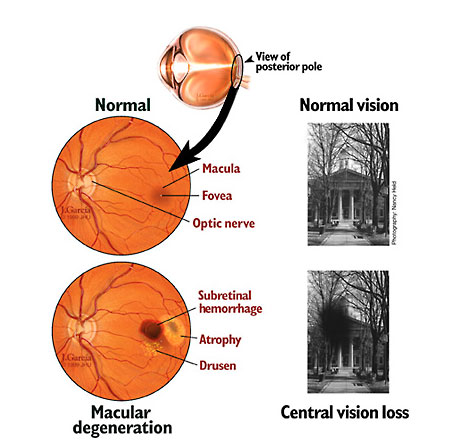There are many factors related to the condition known as Macular Degeneration. The most common cause is a circulatory problem that often increases with age.
The macula itself has a very high requirement for proper nutritional elements, oxygen, and the elimination of waste products in order to function properly. Circulation problems reduce the supply of oxygen and nutrients to the macula and will cause a dysfunction in the macula and, ultimately, its degeneration.
Early signs include:
- Blurred vision with close work
- Seeing straight lines as wavy (doorways appear as a figure of eight)
- Your sight degrades as you look straight at print or faces
- A black hole (starts grey and goes steadily blacker) may form in the centre of your vision
- Sensitivity to bright light and night vision
- You can only adapt very slowly from light to dark
- Eventually you may only have a small amount of peripheral vision
There are two forms of the disease – the wet, more commonly the dry form.
In the dry form, there is a breakdown or thinning of the retinal pigment epithelial cells (RPE) in the macula. In the wet form, the membrane underlying the retina thickens and then breaks.
While there is no standardised treatment for the dry form of AMD, there are natural treatments that can help, especially when it comes to preventing both types of AMD.
Some studies have shown that acupressure can enhance the cellular ATP (Adenosine Triphosphate) synthesising capabilities in the retina, helping to improve visual acuity for AMD patients.
There are also some herbs that may have beneficial effects for the prevention and management of AMD. These include Bilberry, which contains active antioxidant compounds, and also strengthens the capillaries and reduces bleeding in the retina.
Microcurrent stimulation is one of the main acupressure techniques available to treat AMD.



Recent Comments